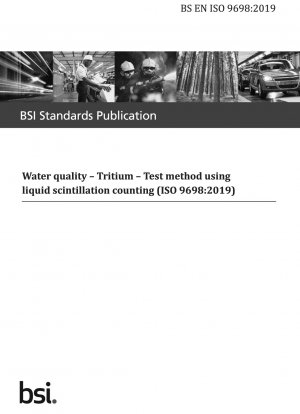BS EN ISO 9698:2019
Water quality. Tritium. Test method using liquid scintillation counting
- Standard No.
- BS EN ISO 9698:2019
- Release Date
- 2019
- Published By
- British Standards Institution (BSI)
- Latest
- BS EN ISO 9698:2019
- Scope
- What is ISO 9698 - LSC for 3H about? ISO 9698 discusses water quality with reference to Tritium (3H). ISO 9698 specifies a method by liquid scintillation counting for the determination of tritium activity concentration in samples of marine waters, surface waters, groundwaters, rain waters, drinking waters or of tritiated water ([3H] H2O) in effluents. ISO 9698 provides a method that is not directly applicable to the analysis of organically bound 3H. Its determination requires additional chemical processing of the sample (such as chemical oxidation or combustion). With suitable technical conditions, the detection limit may be as low as 1 Bq·l−1. 3H activity concentrations below 106 Bq·l−1 can be determined without any sample dilution. Who is ISO 9698 - LSC for 3H for ? ISO 9698 on LSC for 3H water quality is useful for: Government laboratories Industries that release wastewater in natural water bodies Geological scientists Nuclear power plants Public water supply systems Why should you use ISO 9698 - LSC for 3H ? Radioactivity from several naturally occurring and anthropogenic sources is present throughout the environment. Thus, water bodies (such as surface waters, groundwaters, sea waters) can contain radionuclides of natural, human-made, or both origins. ISO 9698 is one of a set of International Standards on test methods dealing with the measurement of the activity concentration of radionuclides in water samples. ISO 9698 provides a test method that is adapted so that the character limits, decis...
BS EN ISO 9698:2019 history
- 2019 BS EN ISO 9698:2019 Water quality. Tritium. Test method using liquid scintillation counting
- 2015 BS EN ISO 9698:2015 Water quality. Determination of tritium activity concentration. Liquid scintillation counting method
